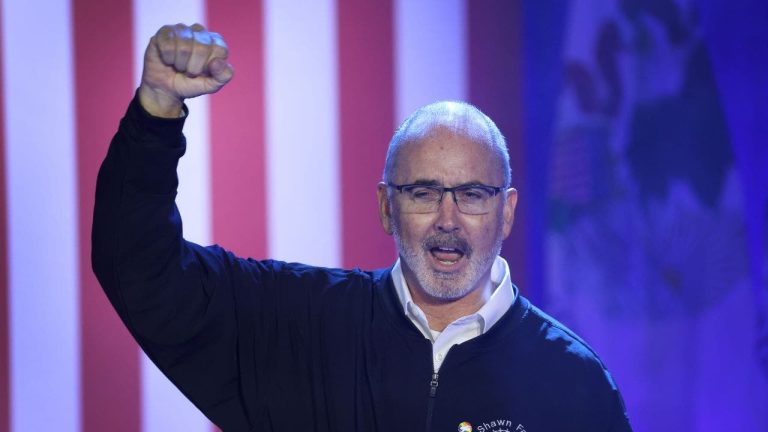
FOX News medical contributor Dr. Marty Makary joined ‘Varney & Co.’ to discuss the healthcare workers’ strike and the widespread reports of dropped or limited vaccine appointments.
Open enrollment starts in November, and it’s important to reflect on the big picture to determine what type of plan you may need as the window to make additions is limited, which includes health savings accounts (HSAs).
“A plan that worked well for you one year may not make sense for you next year,” says Charlene Rhinehart, spokesperson at GoodRx in Chicago.
First, Rhinehart recommends looking at your finances and determining what you would be comfortable paying each month and how much you could spend if you had to pay out of pocket.
FAMILY HEALTHCARE INSURANCE NOW COSTS $24,000
Review Financial Position
- Are you anticipating any major life changes, like getting married or having children?
- Are you planning on retiring in the near future?
- Also, consider your current healthcare needs. Do you have chronic conditions that require a specialist or prescription medication? Do you have a doctor that’s in a network you would prefer to keep seeing?

A doctor reviews a post-operative x-ray. (Jeff Greenberg/Education Images/Universal Images Group via Getty Images / Getty Images)
What is an HSA?
An HSA is a tax-advantaged health savings account. “If you are enrolled in a high deductible healthcare plan (HDHP) where your monthly payments may be lower, but you’re often paying more out of pocket, an HSA allows you to set aside tax-free money to cover select healthcare expenses,” Rhinehart says.
| Ticker | Security | Last | Change | Change % |
|---|---|---|---|---|
| WMT | WALMART INC. | 161.17 | -0.60 | -0.37% |
| WBA | WALGREENS BOOTS ALLIANCE INC. | 21.14 | -0.56 | -2.58% |
| CVS | CVS HEALTH CORP. | 66.29 | -1.69 | -2.49% |
| AMZN | AMAZON.COM INC. | 127.74 | +8.17 | +6.83% |
MR. WONDERFUL SHARES CRITICAL FINANCIAL ADVICE
Getting the most out of your HSA
It’s important to look at your healthcare benefits to get the most out of your HSA. “For example, you should check and see if your employer will contribute to your HSA through a wellness incentive,” Rhinehart tells FOX Business.
Keep in mind, there’s also a limit to how much you can contribute to your HSA each year. According to Rhinehart, for 2024, HSA contribution limits are $4,150 for individuals and $8,300 for families. “Knowing the yearly contribution limit is important in deciding how much you would like your employer to contribute, if this is a benefit you’re eligible for through work,:” she continues. “If you opt for employer contributions, you won’t have to pay taxes on the money they add.”

A young woman addresses her bills in the kitchen. (iStock / iStock)
What if your HSA still has funds at year-end?
HSAs also roll over each year, so don’t feel pressured to use all the funds before the end of the calendar year, says Rhinehart. “Let it roll over to the following year and continue to grow,” she advised.
And if you have money sitting in your account, consider putting it to work by investing it. Your investments grow tax-free, and you don’t have to worry about paying taxes on your withdrawals either as long as you use the funds to pay for qualified medical expenses, she adds.
NEARLY 1 MILLION PRESSURE COOKERS RECALLED

The interior of a Walgreens store. (Walgreens via Businesswire)
How open enrollment can align employee’s healthcare goals
There are several steps you can take, especially during annual enrollment, that may help put you on a stronger financial footing when it comes to your health, Ryan Viktorin, CFP, vice president and financial consultant at Fidelity Investments in Boston, tells FOX Business.
First, Viktorin says to make sure you research your health care options, including what premiums, deductibles and out-of-pocket maximums look like within your plan options.
Then, be sure you understand what kind of preventative care benefits your employer may offer — things like mental health support or physical wellness stipends may come at low or no cost to you, she adds.

The running deck of a Peloton Tread treadmill. (Ethan Miller/Getty Images / Getty Images)
And, for those enrolled in a high-deductible health plan, keep in mind you have access to a health savings account, Viktorin tells FOX Business.
The Fidelity Investments Fall 2023 Health Care Outlook study revealed nearly half of Americans are unfamiliar with HSAs, meaning there are many Americans who could be missing out on the financial benefits an HSA can provide.
Why is having an HSA so valuable?
What many people don’t realize is that HSAs can play a large role in your overall financial plan. “We know there’s a strong link between health and financial well-being, so maximizing the benefits available to you can pay off both now and in the future,” Viktorin continues.
The most important feature of an HSA is the “triple-tax advantage” — in other words, three distinct ways the account is federally tax-advantaged.
According to Viktorin: One, the money you put in, also known as your contributions, goes in pre-tax; two, you can use the account to pay for qualified medical expenses tax-free; and three, you can also invest the money in your HSA to potentially grow to use in the future. “All of this growth is tax-free, too, assuming it’s used for qualified medical expenses,” she says.
HEALTH CARE
Published Oct. 18, 2023 2:45pm EDT
Family health insurance through work now costs $24,000 a year
Premiums for job-based health insurance are up 7% from last year
By Breck Dumas FOXBusiness
close
Premiums for employer-sponsored health insurance have risen sharply over the past year, piling on further costs to businesses and workers already feeling the squeeze from high inflation.
KFF’s annual Employer Health Benefits Survey, released Wednesday, found coverage for a family plan now averages $23,968, with workers typically paying more than $6,500 toward that amount while employers pay the rest.
The cost for single plans rose, too, reaching an average of $8,435 annually.
The cost of job-based health insurance premiums for family plans jumped 7% this year to an average of around $24,000 annually. (Brittany Murray/MediaNews Group/Long Beach Press-Telegram via Getty Images)
The data shows the cost of both family and single plans jumped 7% this year, which KFF said was a “sharp departure” from last year’s survey findings that indicated there was virtually no increase in the price of premiums.
EMPLOYEES CONSIDER WELLNESS PROGRAMS AT WORK CRITICAL FOR JOB CHOICE, REPORT SAYS: ‘RETHINK A FUTURE’
The 7% surge in work-based health insurance costs means coverage rose higher year-over-year than workers’ wages (5.2%) and inflation (5.8%).
The cost of job-based health insurance premiums rose sharply over the past year, impacting more than 150 million Americans. (Matt McClain/The Washington Post via Getty Images)
“Rising employer health care premiums have resumed their nasty ways, a reminder that while the nation has made great progress expanding coverage, people continue to struggle with medical bills, and overall the nation has no strategy on health costs,” KFF President and CEO Drew Altman said.
HOME INSURANCE COSTS ARE RISING: HERE’S WHY
Nearly 153 million Americans receive their health insurance through an employer, who typically pay more than 70% of the cost of coverage for family plans, according to KFF.
A doctor reviews a post-operative x-ray. (Jeff Greenberg/Education Images/Universal Images Group via Getty Images)
The health policy and polling organization said its survey showed workers paid on average $500 more this year toward their premiums than in 2022, and that future out-of-pocket increases could be coming given that 23% of employers said they plan to increase workers’ contributions in the next two years.
GET FOX BUSINESS ON THE GO BY CLICKING HERE






